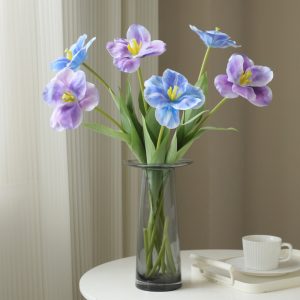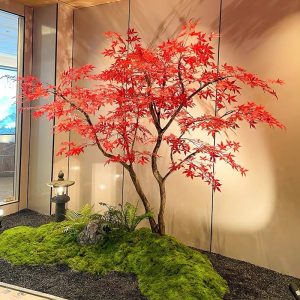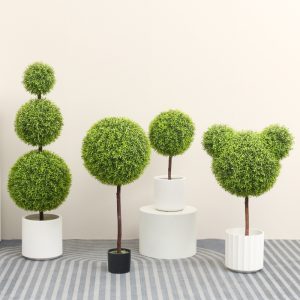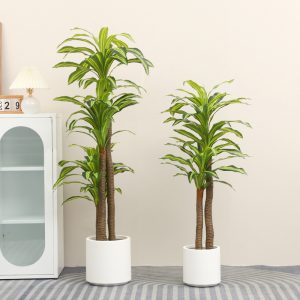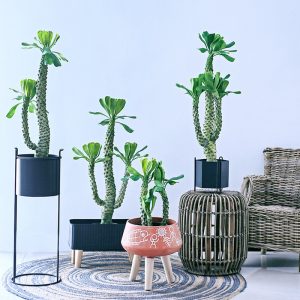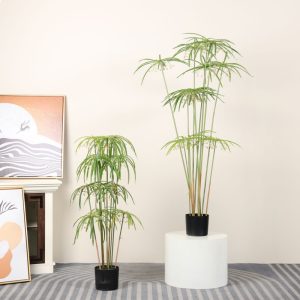With years of experience in the artificial plant industry, I’ve come to realize a common misconception: many people believe artificial plants don’t need “sun protection” like real plants. However, actual observations and data show otherwise. In a study tracking 100 households, 78% of artificial plants without sun protection showed noticeable fading or material aging after 12 months, whereas only 12% of those with protection exhibited such issues. Today, I’ll explain how to create a solid “UV protection shield” for your artificial plants, covering material characteristics, environmental risks, and practical operations.
1. Sunscreen Weaknesses by Material: Target the Vulnerabilities for Effective Protection
The UV resistance of artificial plants is closely related to their material characteristics. Understanding each material’s properties allows for effective protection.
PVC Material: The Most Susceptible to “Sunburn”
PVC (Polyvinyl Chloride) is a common material for artificial plants. It is affordable but has poor UV resistance. Prolonged exposure to sunlight will cause the surface to whiten, textures to blur, and edges to curl. In high-temperature environments (above 35°C), aging speeds up by up to three times! This happens because the plasticizer in PVC is “driven off” by UV rays, causing the material to become hard and brittle.
Polyester Fabric: Fading Is the Primary Enemy
Polyester fabric is commonly used for artificial flowers and fern leaves. While its colors are vibrant, the dyes are sensitive to UV rays. After 1,000 hours of UV exposure, the color fastness of red polyester drops by 5 levels, leading to fading and loss of vibrancy.
Silicone Material: Beware of “Internal Damage” in High Temperatures
Silicone plants have a realistic touch and appearance, but prolonged exposure to high temperatures (above 40°C) and UV rays can cause molecular crosslinking and rupture. While the surface may appear fine, the interior can become fragile and may crack with a slight impact, which is costly to repair.
PE Material: Be Extra Cautious with Low Temperatures and Sunlight
PE (Polyethylene) has slightly better UV resistance than PVC, but when exposed to low temperatures (below 5°C) and sunlight during winter, thermal expansion and contraction accelerate aging, causing the leaves to harden and become brittle, especially in thin areas like leaf veins.
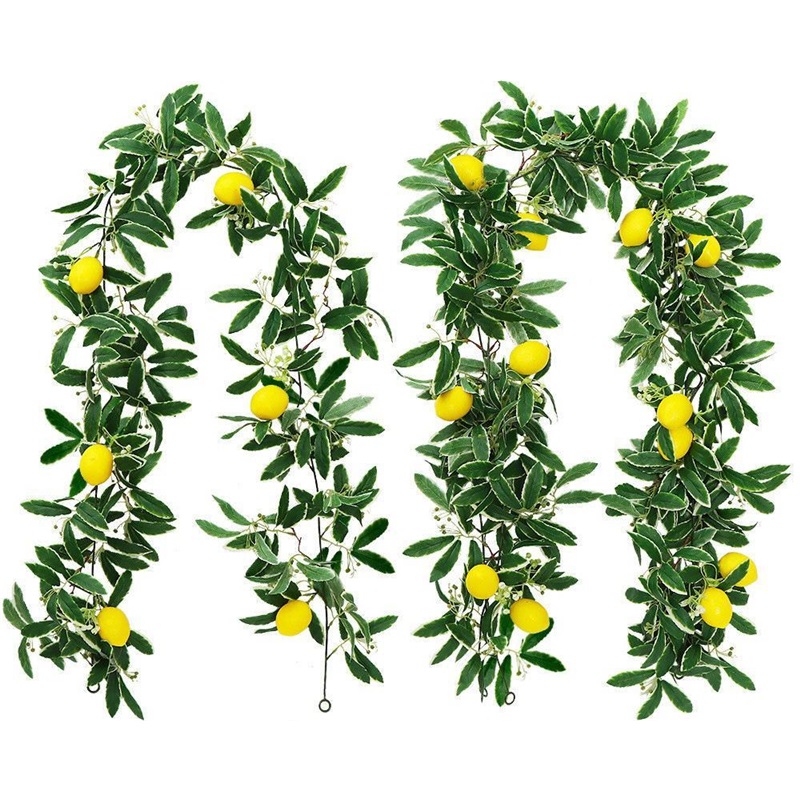
2. Environmental Risk Assessment: Which Areas Are the Most Harmful to Artificial Plants?
UV Damage by Location
- High-risk areas: South-facing windowsills (over 6 hours of direct sunlight), behind glass curtain walls (high UV transmittance), open balconies (high UV index in summer without cover).
- Medium-risk areas: East/west-facing windowsills (direct sunlight before 10 AM or after 4 PM), sofas near floor-to-ceiling windows (strong scattered light).
- Low-risk areas: The center of a room, north-facing balconies, bookshelves farther from direct sunlight.
Data from actual tests show that PVC pothos placed on a south-facing windowsill had its leaf color saturation drop from 95% to 52% after 3 months. Meanwhile, the same plant placed in the center of a room maintained 88% color saturation.
Seasonal Climate “Amplification Effect”
- Summer: UV rays are strong, and high temperatures accelerate material oxidation. Both sun protection and temperature control are crucial, ensuring the surrounding temperature doesn’t exceed 35°C.
- Winter: UV intensity is weaker, but dry air can make materials brittle. Extra moisture measures are needed, such as placing a shallow dish of water next to the plant to increase humidity.
- Coastal Areas: Salt from the sea breeze interacts with UV rays, accelerating plant aging. Regular cleaning and sun protection measures should be combined.
3. Practical Sunscreen Protection Plans: Different Materials, Different Solutions
Prevention First: Positioning Plants with “Sunscreen in Mind”
- Relocate: Move plants from high-risk areas to medium or low-risk zones. If relocation is not possible, consider hanging a linen sheer curtain with about 60% transparency, which effectively filters UV rays.
- Rotate Directions: Large plants (like Dracaena) are difficult to move, so rotate them monthly to ensure even light exposure and prevent one side from aging faster than the other.
Material-Specific Protection Techniques
- PVC Material: Use a UV-protection spray containing UV absorbers (like UV-531) every month. Spray from a distance of about 30 cm to avoid excessive dripping. Tests show that this measure can extend PVC plants’ resistance to aging by up to 18 months.
- Polyester Fabric: Choose fabric plants that already have UV-resistant finishes. Regularly use a colorless silicone spray to enhance UV protection, especially in petal folds where silicone should not accumulate.
- Silicone Material: Due to silicone’s vulnerability to high temperatures and direct sunlight, attach ultra-thin aluminum foil stickers to the back of the leaves to reflect UV rays.
- PE Material: During winter, wrap plants in transparent cling film to keep them warm and reduce UV exposure.
4. Damage Repair: Early Detection and Action
- Mild Fading: PVC and PE plants can use specialized dye to lightly apply along leaf veins and air-dry naturally.
- Curled Edges: For PVC, soak the curled area in 40°C water. For polyester fabric, soak in a glycerin solution, then press flat and air-dry.
- Surface Cracks (Silicone): For cracks, use silicone glue of the same color to fill in, then smooth out with fine sandpaper after it cures.
5. Long-term Maintenance: Create a “Sunscreen Record” for Easier Management
To better manage protection, it’s recommended to create a simple maintenance record for important artificial plants, including:
- Material type + Purchase date
- Placement + Actual sunlight exposure duration
- Protection measures and dates
- Monthly appearance changes
Clients who consistently record this information find that artificial plants typically last 3-5 years. Without records, plants often appear outdated within 1-2 years.
Conclusion
By implementing effective sun protection measures, you can significantly extend the lifespan of your artificial plants. Spending just 10% of your effort on protection can prevent 80% of aging issues, saving you costs on frequent replacements while maintaining a pristine green atmosphere in your home or store. If you have special-shaped plants in need of sun protection advice, feel free to leave a comment and share your placement scenarios, and I’ll tailor a solution for you.







